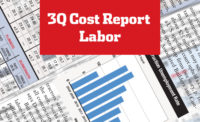Despite the construction market upheaval during the pandemic, labor rates remain relatively steady. Analysts noted some short-term adjustments to compensation by construction employers in 2020, with ongoing labor shortages continuing to put pressure on wages.
One general employment trend seen coming out of the pandemic has been the difficulty in hiring hourly workers for minimum- and low-wage jobs—a movement that may now be reverberating in construction.
While much of the industry continues to offer modest wage hikes, some of its highest increases are in lower paid trades, says Jeff Robinson, president of compensation consulting firm Personnel Administration Services. In 2020, merit shop employers offered average wage increases of 3.4% across all trades, according to its 2021 Merit Shop Wage and Benefit Survey. But laborers, who rank as lowest paid among trades surveyed, saw a 4.7% increase—the largest hike reported.
In a separate survey of heavy-highway merit shop employers, Robinson says that trend was even more evident among workers not in skilled trades, such as flaggers. More than 25% of flaggers earmed less than $15 per hour, says the survey. Other industries raising their minimum pay can put pressure on unskilled workers' wages. Several cities have set a minimum wage at $15 per hour or higher, including Seattle at $16.69 per hour. A fast-food chain in the city recently announced it would offer $19 per hour to new employees and $20 per hour after they complete training. “I don’t see that pressure going away,” he says.
While the lower end of the pay scale rises, wage increases on average have remained relatively modest. After registering hikes of 3.4% for merit shop workers in 2020, employers predicted a 3.2% average increase this year. Robinson expects that forecast is low. Since the PAS survey was released in May, demand for workers has risen and the cost of living has loomed above 5% since April. Robinson expects average wage hikes for merit shop workers will hit at least 3.6%.
Wage pressures may also affect the union trades. Robbie Hunter, outgoing president of the California Building Trades, says many merit shop workers and “underground economy” workers on construction sites can “get higher wages working at McDonalds.” He hopes that translates into more interest in higher-wage union jobs, but recognizes the struggle to attract young workers into construction. “We will need to continue to offer a good wage and benefits,” he says.
Union settlements remained relatively stable during the pandemic, says Construction Labor Research Council data. First-year increases averaged 3% in 2019 and by early 2021, it dipped to 2.6%. But first-year hikes are back to 2.9%, says Carey Peters, executive director.
There could be competing factors at play, he says. “You do have a labor shortage, which would tend to drive rates up,” he says. “But the pandemic reduced work and would tend to drive rates down. The result was a modest down tick in increases.”
In a sign of some market uncertainty, the settlement length also changed significantly.
In 2019, 68% of agreements had a three-year length. That dropped to 44% in 2020. Meanwhile, one-year and two-year deals rose from 4% to 11% and from 6% to 14%, respectively.
So far in 2021, three-year agreements are trending back up to 49% of deals, while one-year and two-year deals are 5% and 11%, respectively.




Post a comment to this article
Report Abusive Comment